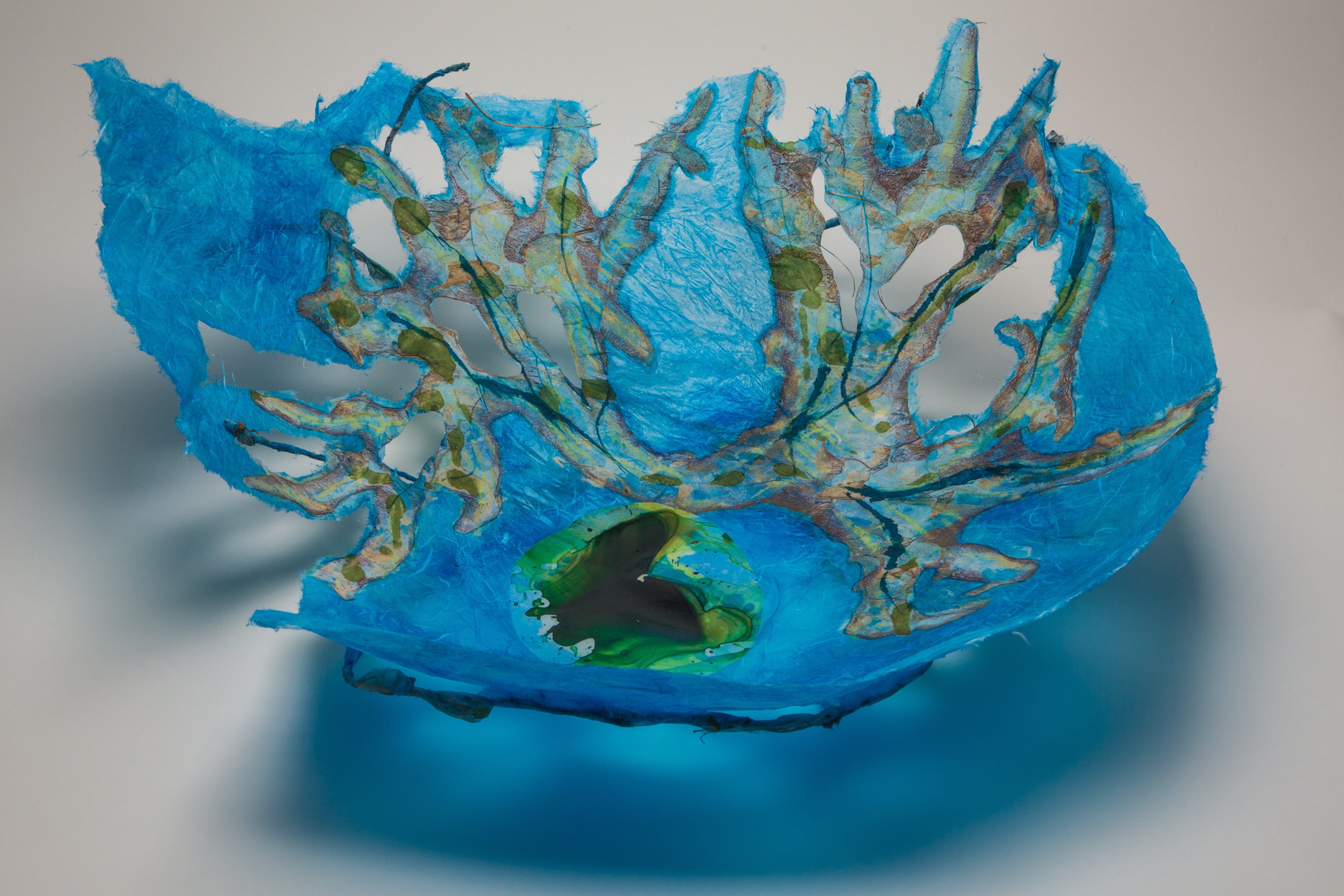
30 Aug Micheline Klagsbrun at Gallery 81435, “Remains To Be Seen”
Telluride Arts’ First Thursday Art Walk is a festive celebration of the arts in downtown Telluride for art lovers, community, and friends. Participating venues host receptions from 5 –8 p.m. to introduce new exhibits and artists.
A free gallery guide offers a self-guided tour that can be used any time to find galleries open most days. Guides are available at participating venues and at the Telluride Arts offices located across the street from Telluride Library at 135 W Pacific Avenue. Listen to Open Art Radio on KOTO from 12-1 p.m. on First Thursdays to hear interviews with the artists.
Easily one of the most important shows in the September line-up is Micheline Klagsbrun’s “Remains To Be Seen.” The latest body of work of this internationally renowned artist is now up at Telluride Arts’ Gallery 81435, although the official opening of the show and artist’s reception coincides with Art Walk. That date is Thursday, September 7.
Go here for other Art Work happenings.
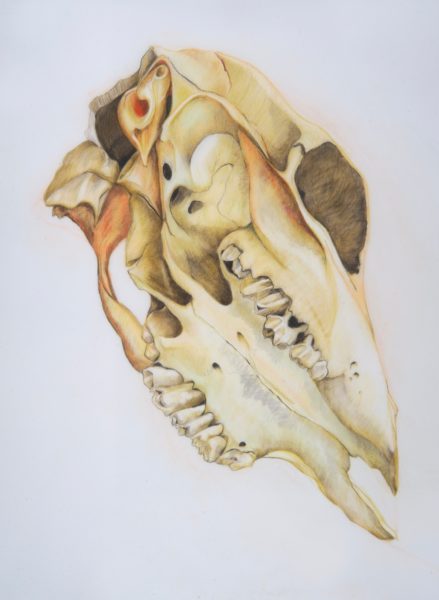
Bird-Orchid Cowskull
Apollo swiped right.
Daphne swiped left.
Then the whole encounter really went south.
Apollo wound up frustrated; Daphne wound up a tree. (No really, she was turned into an actual tree.)
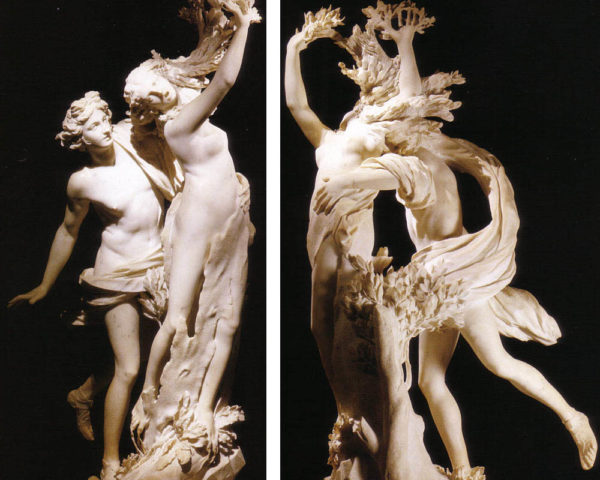
Bernini’s Apollo & Daphne
Ovid tells that whole sad story in his magnum opus Metamorphoses.
Bernini immortalizes the tale of whoa in a sensuous marble sculpture housed today in Rome’s Villa Borghese.
Micheline Klagsbrun is a student of Ovid, a recorder of myth and a master of the narrative impulse: her images in all their various beguiling permutations are as much about story as technical virtuosity – but when the two strands stitch together, the resulting work tells beautiful stories of transformation and synchronicity.
Klagsbrun’s early work from the mid-1990s was predominantly figurative and narrative-based, inspired directly by Ovid’s epic and the mythological stories of desire and punishment, passion and sacrifice, fear and courage, endurance and victory. Inhabited by nymphs and sirens, those paintings and drawings are soft and unstable, depicting imagery of body parts— limbs, arteries, and veins—intertwined with uprooted trees and branches, a direct quote of Daphne’s story.
According to a senior curator at the Phillips Collection in Washington D.C. where Klagsbrun had a major show:
“Over the years, the artist gradually shifted towards more diluted and abstracted forms that fused human figure with either bestiary (anaconda, python, and jelly-fish); monsters (medusa, chimera and centaurs); or botany (wild orchids, hibiscus, lotus, seedpods, tree branches and twigs). Fluctuating between creepy and sensual, menacing and erotic, these paintings and drawings are visual transcriptions of physical and emotional upheavals.
The most recent work… reveals another degree of separation from both the mythological subjects and representational style. Here, the narrative gives way to suggestion, expressed best through the language of abstraction. By staining, pouring, and splashing inks on canvases and vellum sheets, on the one hand, and layering and folding papers into three-dimensional, organic shapes on the other, Klagsbrun arrived at a new vocabulary where the bodies are almost completely distilled in fluid and translucent surfaces of lines, colors, and textures. Displayed side by side, these new paintings, works on paper, and sculptural works are all diaphanous at heart. Mutating from subtle, delicate, and graceful to highly expressive, forceful, and almost violent, they appear flawless, transient, and ethereal…
The sculptural pieces—reminiscent of bowls, vessels, coracles, or boats—are natural outgrowths of the artist’s paintings and drawings. They are containers, or holders made of papier-mâché with added layers of organic elements such as palm leaves, shells, and tree branches, ..”
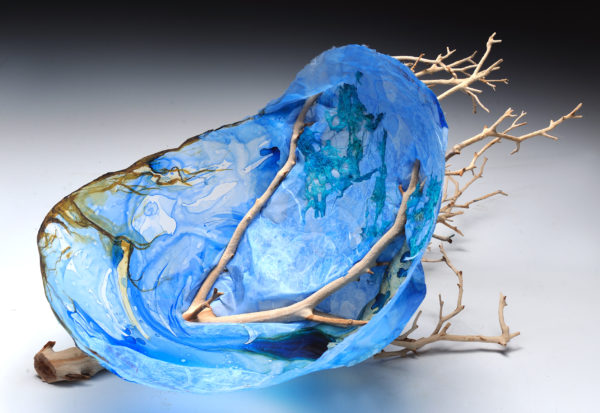
Ocean Nest
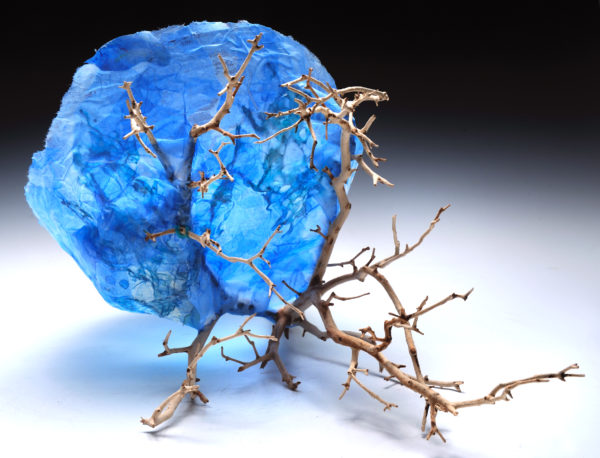
Ocean’s Nest, back view
Klagsbrun’s newest work, however abstracted and now featured at Telluride Arts’ Gallery 81435, still pays homage to Ovid. It is still all about being and becoming. The opening of her show coincides with the September Art Walk, Thursday, September 7, 5 – 8 p.m.
“… The translucent paper, liquid pigments and blue-heavy palette suggest water and flight, while wood and bark represent the heavier and more grounded. Klagsbrun illustrates how life changes both in and by her work, which itself is transforming from traditional painting into something more abstract and sculptural….,” from a 2015 review in The Washington Post.
The proper response to Klagsbrun’s ink and colored pencil drawings on vellum, to her large-scale canvases, 3D wall hangings and sculptural pieces, is a double-take: Now you see it; now you see it differently.
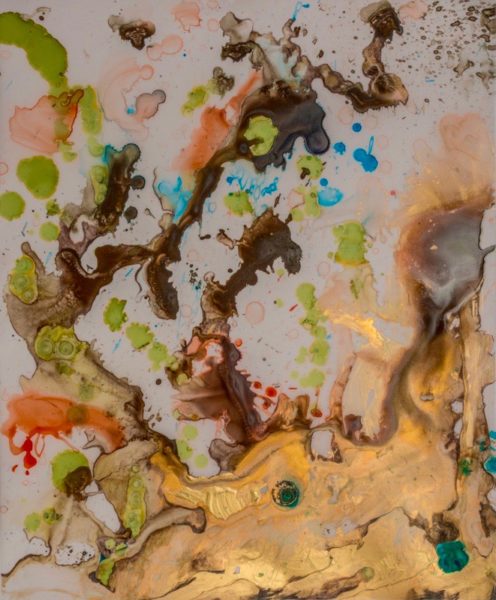
Grandmother Tree, ink+ color pencil on vellum, 14” x 17”.
Because, well….
What is happening to you right now as you are reading these words?
Is your mind wandering?
Is your attention shifting to your honey-do list?
Are you focused, but uncomfortable from sitting too long?
One thing for sure: something about and around you is changing because “Change is the only constant in life,” (Heraclitus).
Restated in the Buddhist tradition, all of conditioned existence, without exception, is transient, evanescent and inconstant.
We cannot step into the same river twice.
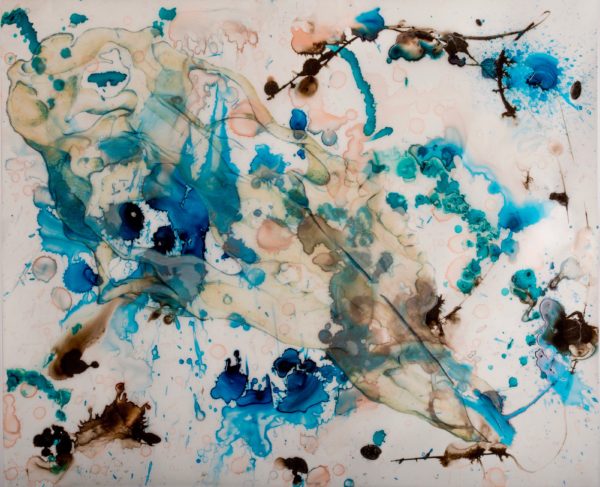
Ghost Skull, ink+ color pencil on vellum 14” x 17.”
The idea of constant change, transformation, metamorphosis, shape-shifting (literal and metaphorical), call the phenomenon what you like, is, as suggested above, the through line in Ovid’s great work, Metamorphoses, which is Klagsbrun’s bible or better, her insistent muse.
In Metamorphoses, Ovid tells stories of transformations among people, animals, gods, plants stones, water and trees. He was drawn to the particular theme of because, according the intro:
“…it gave him warrant to retell stories that he happened to like, stories drawn from Greek myths that focused on (and explained) how given entities came into existence, in particular how certain beings, both semi-divine and divine, were transformed into animals, vegetables, and minerals. This seemingly limitless source, a narratological paradise, offered the storyteller all the material he needed to construct vivid characters, dramatic conflicts, and surprising outcomes.”
It offers Klagsbrun exactly the same bounty.
Populated by hybrid forms—natural and human, animate and inanimate— Klagsbrun’s magical art reflects an interplay of lines, colors and textures. Permeated with light, pieces seem weightless and evanescent, though paradoxically, they are also weighty, thematically and formally, in the underlying notion of change or the impermanence of all images, ideas and forms of being.
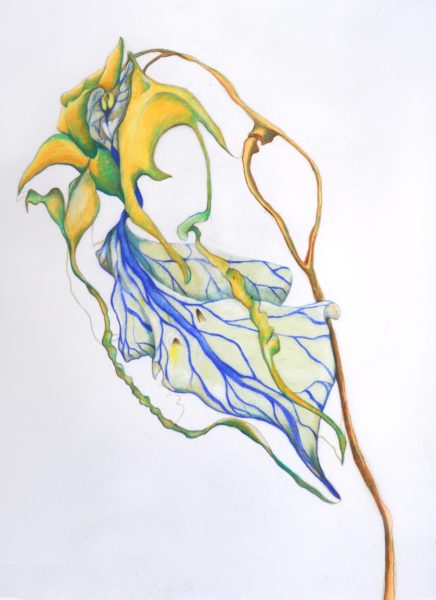
Cowskull Bird Orchid
Researching the beliefs and spiritual practices of the Utes, native to Colorado and the original inhabitants of the Telluride region, Klagsbrun found interesting commonalities between these ancient and modern cultures in their ideas and narratives.
“On a simple level, I began this journey with the intention of displaying work done in my East Coast studio with the work I produced here in Telluride. I have always been interested in the role of place in art. At a deeper level, I am also fascinated by the parallels that can be found between cultures widely separated by time and geography…,” explains the artist.
In other words, Klagsbrun found synchronicity or meaningful coincidence across cultures with no other discernible causal connection. These happenstances, which historically have occurred throughout human history like magic when the time is right, were then made manifest in myth.
Klagbrun’s affinity to such subjects is no big surprise given her background as a clinical psychologist because synchronistic events are seen as bridges between the inner world of the psyche and the outer world of reality, between mind and matter. The influence of Surrealism with its stress on the power of the unconscious is also there as the fertile ground for the artist’s imagery.
Micheline Klagsbrun’s exhibit at Telluride Arts’ Gallery 81435 includes two series of works on paper done in ink and color on vellum and several 3D sculptures. The East Coast series evolved from a cow skull; the Telluride series was inspired by a deer skull.
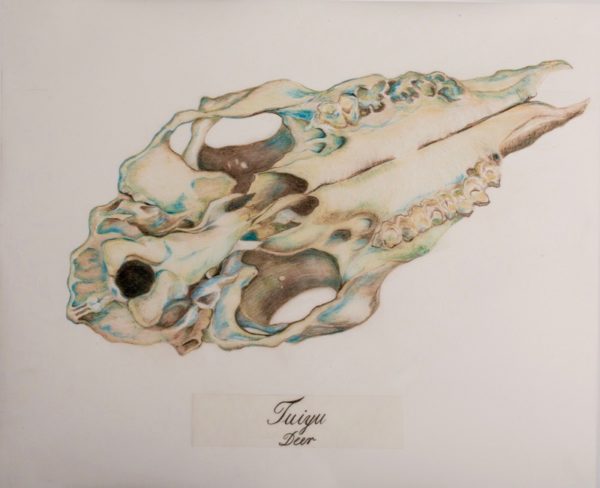
Tuiyu (Deer), color pencil on vellum 11″ x 14.”
In the Southwest Native American cultures, deer are symbols of fertility and often also play a role in creation mythology. Deer are believed to sacrifice themselves to feed the people and/or are considered caretakers of the earth.
In Ovid’s world, in Greek mythology, the deer is particularly associated with Artemis in her role as virginal huntress. Actaeon, after witnessing the nude figure of Artemis bathing in a pool, was transformed by Artemis into a stag that his own hounds tore to pieces.
Not a pretty picture.
Klagsbrun’s are…
Pretty and profound.
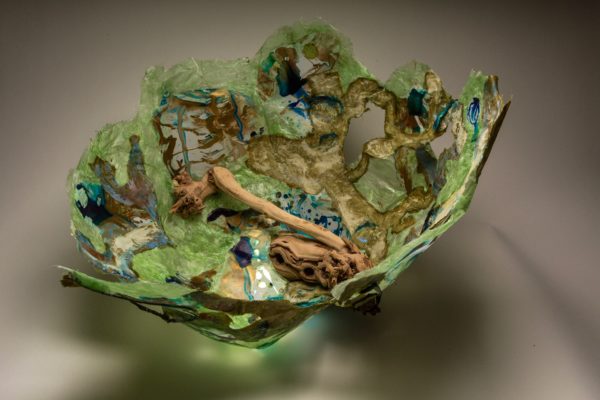
Eye Bowl
More about Micheline Klagsbrun:
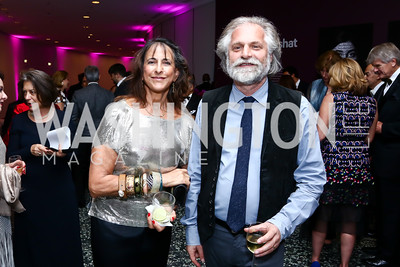
Micheline Klagsbrun and Ken Grossinger. Photo by Tony Powell. Hirshhorn Museum Facing History Gala. May 16, 2015.
Klagsbrun was born and raised in London. She received a doctorate in clinical psychology from the University of Cambridge and subsequently worked at the Center of Family Research at George Washington University.
Klagsbrun studied art first in Paris with Alfredo Echeverria and later at the Corcoran School of Art in Washington D.C. with Gene Davis and Bill Newman.
She has exhibited nationally in New York and Washington D.C. and now Telluride and also internationally in Beijing, China; Aswan, Egypt and New Delhi, India.
Klagsbrun’s work is also found in numerous private collections worldwide.
Micheline Klagsbrun and her husband Ken Grossinger founded and run the CrossCurrents Foundation, which as part of its mission sponsors art to promote social justice and heighten public engagement with key social issues.
Klagbrun also serves on several Boards of Directors. Through the Corcoran Outreach program, she served for a number of years as a mentor for inner-city youth.


Sorry, the comment form is closed at this time.